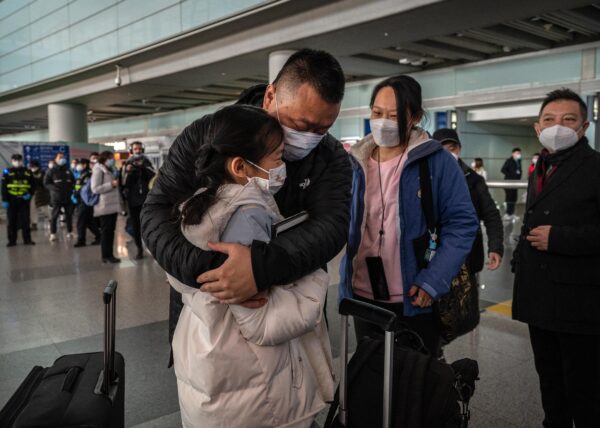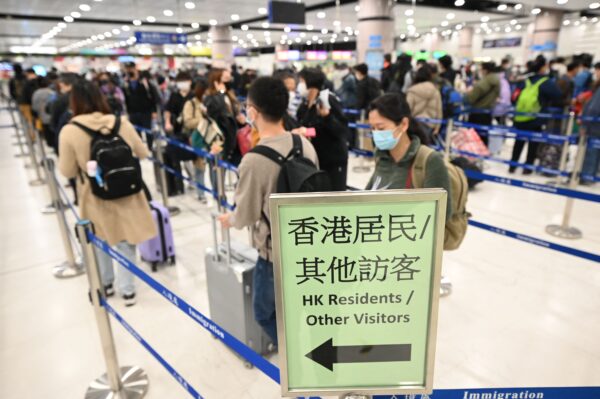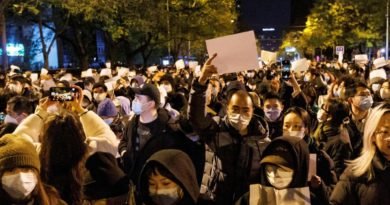Amid COVID Surge, China Reopens Borders After 3 Years
Distressed Patriotic Flag Unisex T-Shirt - Celebrate Comfort and Country $11.29 USD Get it here>>

China has lifted mandatory quarantine rules for inbound passengers and allowed its citizens to head abroad, triggering a homecoming wave. This comes amid a COVID explosion across the nation, which has stocked global concerns.
From Sunday, international travelers are free to enter China’s mainland and no longer need to undergo centralized quarantine at hotels. The border reopening amounts to the final step in dismantling the zero-COVID policy that has hammered the country’s economy and led to severe suffering among the populace.
While incoming visitors still need to present a negative PCR test result within 48 hours of departure, the relaxation of cross-border travel restrictions ahead of China’s lunar year was welcomed by many who haven’t seen their families for nearly three years under the draconian COVID curbs. On Sunday, long queues formed at Hong Kong’s international airport for flights to Beijing and other major mainland cities, after the former British colony allowed people to cross the border with the mainland without being quarantined.

Meanwhile, a flux of mainland Chinese tourists is preparing to head abroad. On Sunday, Chinese authorities also resumed issuing passports and travel visas for mainland residents. Beijing also has quotas on the number of people who can travel between Hong Kong and China each day.
But travel is not expected to quickly return to pre-pandemic levels due to a dearth of international flights and other factors. Japan in December announced it would limit airlines increasing flights to China as part of its border control measures for travelers from China in response to a surge of infections in the nation.
Global Concerns
China is battling with a massive outbreak that has yet to peak. China’s top health body stopped publishing daily infections and has acknowledged only a handful of deaths since early December, when the regime abruptly retreated from its zero-COVID policy on the heels of nationwide protests.
But as many as 248 million people, or 18 percent of the country’s population, were estimated to have caught the virus between Dec. 1 to 20, according to a memo from the health regulator’s internal meeting leaked online and confirmed by news outlets. Local officials and domestic health experts estimated the infection rate likely exceeded 50 percent in multiple provinces and reached 80 percent in Beijing.

The World Health Organisation said on Jan. 4 that China’s COVID data underrepresents the number of hospitalizations and deaths from the disease.
The rapid surge in infections and growing doubts over official tallies have sparked international concerns, particularly regarding the possibility of a new, stronger variant emerging out of China.
The United States and more than a dozen of countries currently require a negative COVID test result for visitors from China. The U.S. Centers for Disease Control and Prevention said the measure is meant to impede the spread of COVID on American soil, given “the lack of adequate and transparent epidemiological and viral genomic sequence data.” The agency is now considering measures like sampling wastewater from flights from China to track potential new variants.
The regime has vehemently objected to such testing rules on Chinese visitors, accusing the measures as being politically motivated while threatening unspecified countermeasures.
“We will take corresponding measures based on the principle of reciprocity according to different situations,” China’s foreign ministry spokesperson Mao Ning said on Jan. 3.
Despite Beijing’s protests, Japan tightened its border controls on Chinese visitors on Jan. 4. Additional measures require negative COVID tests taken within 72 hours of passengers boarding direct flights from China, the government said. The tightening came after a Japanese health ministry tally showed 53 of 56 international travelers who tested positive for COVID on arrival at airports on Jan. 3 were from China.
Taiwan also reported a relatively high infection rate from travelers from China. Up to 28 percent of arrivals from mainland China tested positive for COVID on Jan. 1, the first day when the authorities began screening passengers from its neighbor, according to the Taiwan Centers for Disease Control.
Travel Rush
Many in Hong Kong are now rushing for long-awaited reunions in China. Some Hong Kong media news outlets estimated that thousands of people were traveling across the border.
“I’m so happy, so happy, so excited. I haven’t seen my parents for many years,” said Hong Kong resident Teresa Chow as she and dozens of other travelers prepared to cross into mainland China from Hong Kong’s Lok Ma Chau checkpoint early on Sunday.
“My parents are not in good health, and I couldn’t go back to see them even when they had colon cancer, so I’m really happy to go back and see them now,” she told Reuters, adding that she plans to head to her hometown in eastern China’s Ningbo city.

The border opening follows Saturday’s start of “chun yun,” the first 40-day period of Lunar New Year travel, which before the pandemic was the world’s largest annual migration of people returning to their hometowns to spend holidays with family.
Some 2 billion trips are expected to be made this season, nearly double last year’s movement and recovering to 70 percent of 2019 levels, authorities said.
As a huge number of people prepare for their trips, outside experts offered a bleak scenario of the impending public holiday. As many as 25,000 Chinese people may die from COVID-19 around Jan. 23, the second day of the Lunar New Year, according to the latest estimates by Airfinity, a British-based health analytics firm. Infection is likely to peak on Jan. 13 when 3.7 million people may catch the virus a day, it said.
Reuters contributed to this report.





